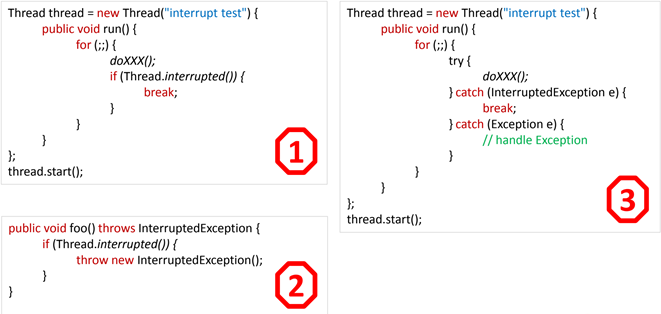正常结束(执行完成)
使用退出标志退出线程
一般 run()方法执行完,线程就会正常结束,然而,常常有些线程是伺服线程。它们需要长时间的运行,只有在外部某些条件满足的情况下,才能关闭这些线程。使用一个变量来控制循环,例如:最直接的方法就是设一个boolean类型的标志,并通过设置这个标志为true或false 来控制while 循环是否退出,代码示例:
1 | package com.sunld.thread; |
定义了一个退出标志 exit,当 exit 为 true 时,while 循环退出,exit 的默认值为 false.在定义 exit 时,使用了一个 Java 关键字 volatile,这个关键字的目的是使 exit 同步,也就是说在同一时刻只能由一个线程来修改 exit 的值。
interrupt方法结束线程
Thread中断方法说明
1 | /** |
类库中的中断
- FutureTask中的cancel方法,如果传入的参数为true,它将会在正在运行异步任务的线程上调用interrupt方法,如果正在执行的异步任务中的代码没有对中断做出响应,那么cancel方法中的参数将不会起到什么效果;
- ThreadPoolExecutor中的shutdownNow方法会遍历线程池中的工作线程并调用线程的interrupt方法来中断线程,如果工作线程中正在执行的任务没有对中断做出响应,任务将一直执行直到正常结束。
中断处理
- interrupt()方法仅仅是在当前线程中打了一个停止的标识将中断标志修改为true,并没有真正的停止线程:如果在此基础上进入堵塞状态(sleep(),wait(),join()),马上就会抛出一个InterruptedException,且中断标志被清除,重新设置为false,线程退出。
- 如果遇到的是可中断的阻塞方法抛出InterruptedException:可以继续向上层抛出该异常。若有时候不太方便在方法上抛出InterruptedException,比如要实现的某个接口中的方法签名上没有throws InterruptedException,这时就可以捕获可中断方法的InterruptedException并且恢复异常(重新设置中断)。
- 阻塞中的那个方法抛出这个异常,通过代码捕获该异常,然后 break 跳出循环状态,从而让我们有机会结束这个线程的执行。通常很多人认为只要调用 interrupt 方法线程就会结束,实际上是错的, 一定要先捕获 InterruptedException 异常之后通过 break 来跳出循环,才能正常结束 run 方法。
- 线程未处于阻塞状态:使用 isInterrupted()判断线程的中断标志来退出循环。当使用interrupt()方法时,中断标志就会置 true,和使用自定义的标志来控制循环是一样的道理。
中断响应
有些程序可能一检测到中断就立马将线程终止,有些可能是退出当前执行的任务,继续执行下一个任务……作为一种协作机制,这要与中断方协商好,当调用interrupt会发生些什么都是事先知道的,如做一些事务回滚操作,一些清理工作,一些补偿操作等。若不确定调用某个线程的interrupt后该线程会做出什么样的响应,那就不应当中断该线程。
程序应该对线程中断作出恰当的响应。只有正确响应中断才能更好的结束线程。

中断示例
1 | package com.sunld.thread; |
stop 方法终止线程(线程不安全)
- stop、destroy方法已经被Java废弃
- 原理:强制杀死线程
- 不安全原因:thread.stop()调用之后,创建子线程的线程就会抛出 ThreadDeatherror 的错误,并且会释放子线程所持有的所有锁。导致数据不一致等不可控情况
中断的使用场景
- 点击某个桌面应用中的取消按钮时;
- 某个操作超过了一定的执行时间限制需要中止时;
- 多个线程做相同的事情,只要一个线程成功其它线程都可以取消时;
- 一组线程中的一个或多个出现错误导致整组都无法继续时;
- 当一个应用或服务需要停止时。

